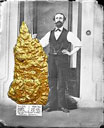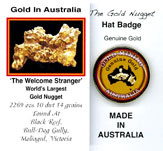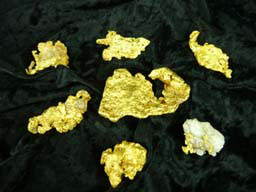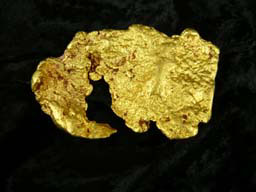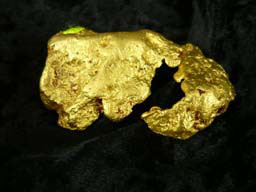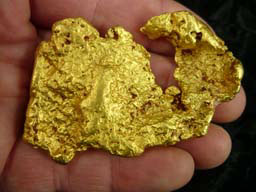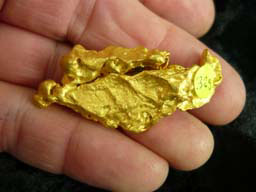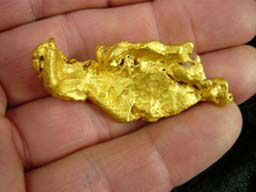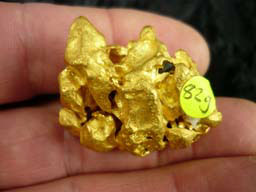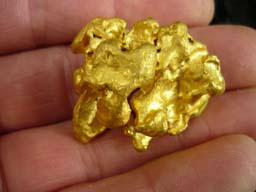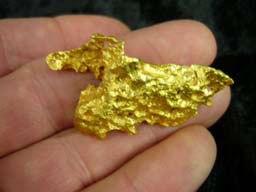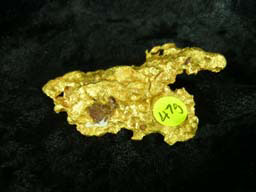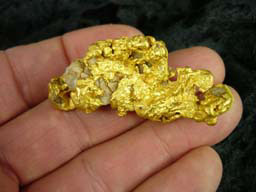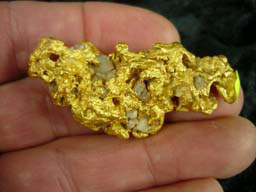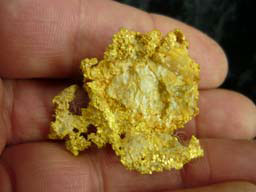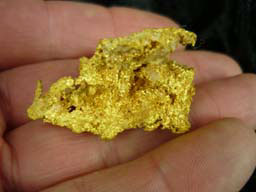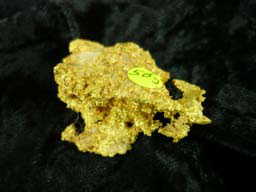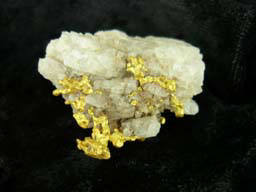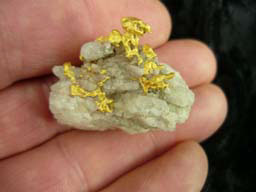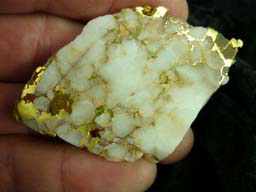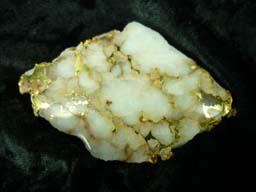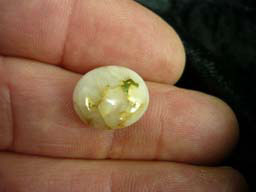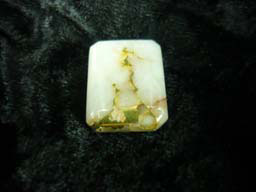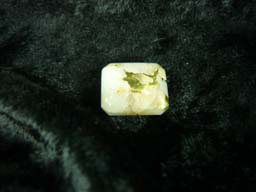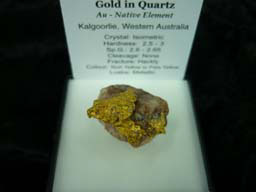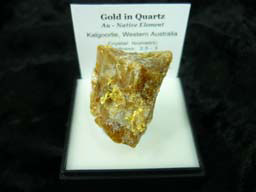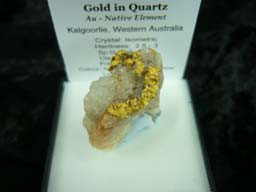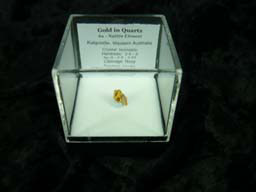|
Gold Panning
Gold Panning -
Before metal detectors,
gold panning was the prospector's best means of locating gold.
The gold pan can be anything round and dish shaped from a custom
made pan to a large deep dinner bowl.
However, the equipment
you take should include a pick, shovel, geological hammer, al
long handle shovel, gold pan and sieves. The gold pan should
be large enough to catch everything that falls through the sieves.
A magnet would also be handy to remove any heavy magnetic material
from the pan and another useful item would be a small tarp to
spread out over the ground to sort recovered material. An experienced
gold prospector will use his sieves to advantage because sieving,
if done correctly, will enable the prospector to locate all the
heavier material in the centre of the sieve; this method will
be described later.
Gold is the heaviest metal
most likely to be found in creeks. When panning for gold identify
an area where gold has been reported and locate an area in a
creek where gold is most likely to be deposited.
The best time to search
for gold is after a flood because a lot of lighter material will
be washed away.
Choose an area in the creek
where flow is lowest and remove larger rock to uncover gravel
beds. It should also be remembered that the river or creek has
not always been exactly where it is today and by discovering
the old river course could yield gold that was deposited years
or even centuries ago. Gravel beds containing the gold may now
be covered in silt, soil or heavy clay so it may be necessary
to remove vegetation and topsoil to get to the gravel beds.
If the location is close
to the river a channel should be made to ensure that plenty of
water is available for sieving and panning.
Gold will sink into the
riverbed, so a lot of digging may necessary to remove the overburden.
Ideally, sieving is recommended to remove larger stones from
the dig and catch the smaller gravel in the gold pan. Check every
stone before discarding because some rocks could contain gold.
The gold may not be visible so check the weight by feel to gauge
the specific gravity. Even a small amount of gold in a rock will
alter the feel of the stone. This method obviously comes with
experience and if in doubt chip the rock to see if any gold is
visible.
Wooden nesting sieves are
ideal because they are easier to handle when using the sieving
technique.
Sieving Technique
Place the pan in the water
and then place the 1/2" in sieve over the top of the 1/4"
sieve, which is now located on top of the gold pan, and shovel
the gravel into the 1/2" sieve. Don't over fill the sieve
because it will be too heavy and difficult to handle.
The secret of sieving for
gems and gold is to manipulate the heavier material to the centre
of the sieves. This achieved with a moderate amount of skill.
Place your hands beneath the gold pan at 180º and lift the
pan. Keep the stack immersed in water and with a slow up and
down motion rotate the stack in an anti-clockwise direction.
As you rotate the stack the smaller material will filter through
the sieves and into the pan. Occasionally give the stack a vigorous
shake from side to side to release trapped smaller material and
centre the heavier material.
When you are satisfied
with the result, release the pan and the 1/4" sieve and
let them rest on the bottom still beneath the 1/2" sieve.
Remove the larger stones from the top sieve examining them as
you go until all the very large pieces have been confidently
discarded. With the same motion as described, lift and drop the
sieve in a bouncing motion as you rotate in an anti-clockwise
direction. The lighter material will drift to the perimeter of
the sieve. Vigorously shake the sieve from side to side and repeat
the revolving and bouncing motion until you are satisfied that
all heavier material remains in the centre of the sieve. Remove
material from the perimeter of the sieve as necessary during
this operation. Go to the bank and quickly flip the sieve over
onto the tarp.
Sort through the heavy
material in the centre of the sieve. It is possible that heavy
gemstones may also be in the pile so some knowledge of gems is
an advantage.
Gemstones likely to be
found in the sieve are zircon, corundum (Sapphire is the gem
variety), spinel, garnet, tourmaline and topaz.
Heavier common minerals
that could be in the gravel are rutile, cassiterite (tin), Ilmenite
and magnetite. Remember, gold could be covered in ironstone so
don't discard rusty looking heavy minerals. Keep anything of
interest and clean off the tarp.
Repeat the process for
the 1/4" sieve and keep anything heavy or anything that
looks like a gemstone. Quite often clear quartz (Rock Crystal)
will be found and these can also be made into attractive gemstones
especially if they have inclusions of other minerals such as
rutile and tourmaline.
Panning will concentrate
the heavy material and the pan riffle will help prevent small
gold flakes from drifting out of the pan. Most of the light materials
in the pan will consist of mica quartz and feldspar the common
minerals in igneous rocks and as the pan is rotated with a bouncing
motion these minerals will float to the perimeter of the pan
whilst the heavier minerals sink to the bottom of the pan.
Tilt the pan slightly,
whilst immersed in water, and with a soft shaking motion allow
the lighter minerals to 'float' over the edge of the pan. The
riffle will prevent heavier minerals from being lost.
You now have a concentrate
of heavy minerals, which may include specs of gold. All the heavy
minerals should be carefully collected to sort later so that
your time is more effectively spent in gathering more heavy minerals.
To the experienced eye,
gold is unmistakable but the novice can often mistake other minerals
such as mica, pyrite and chalcopyrite for gold. These minerals
are historically known as "Fool's Gold" and are much
more common than gold. All three are much lighter in weight than
gold, mica being the lightest and will often be observed close
or on top of all other materials in the creek bed. Pyrite and
chalcopyrite being heavier than the other common minerals, quartz
and feldspar, will be lower down in the gravel beds.
Apart from its weight,
gold has a distinctive yellow colour compared to the brassy colour
of the other minerals our gold specimens will assist in your
identification of this noble and precious metal.
|




